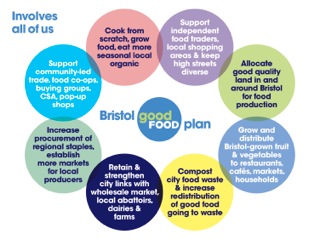Green party councillor, Gus Hoyt, says Bristol’s mayoral Cabinet has a “green heart at its core”. (Image credit Bristol 24-7)
Previously city councillors had voted for their leader. But the Coalition government gave ten of England’s biggest cities the option to vote for its own. Last May, Bristol people voted in a referendum to elect their own mayor, the only city to do so. In November, independent candidate, George Ferguson, became the city’s first “directly-elected” mayor.
Does a directly-elected mayor give more power to the people because they (rather than councillors) are voting? Or does the new role give too much power to one person, the mayor? But that’s another story.
Last November, Gus Hoyt, Bristol North’s first Green party councillor, got a late-night call from newly-elected mayor, George Ferguson, inviting him to join the new mayoral “rainbow” cabinet. Gus Hoyt explains in his blog why he accepted.
It’s a question because the Green Party is opposed to the cuts – yet the Bristol mayoral cabinet is pledged to cut £35 million. The intention of the cabinet is to minimise hardship, says George Ferguson. “I’m trying to minimise the effect on services,” he says.
Personally, I don’t get this cuts business. For a start, the UK is one of the most powerful countries in the world. To my mind, Austerity Britain is a marketing slogan to cover up the reality which is: “Stop giving money to the poor, so the rich can get richer.” But I digress.
Last night at a Bristol Friends of the Earth meeting, guest speaker, Gus Hoyt – focusing on food and energy – described the positive things the cabinet hopes to achieve.
Green Bristol food vision
- Make it easier for local food producers to sell their produce, building connections with local supply chains
- Turn Bristol into a bee capital (Paris has over 400 hives)
- Establish a “nuts-and-bolts” food market at Bristol Temple Meads railway station new enterprise zone – if successful it could be replicated in areas of deprivation
- Aim to declare Bristol a zero waste city hopefully working with green-friendly Labour MP for Bristol East, Kerry McCarthy, who introduced a food waste bill in parliament
- One fruit tree to be planted for each Bristol child born so apples and nuts can be harvested at will, and children can learn where food comes from (it really does grow on trees.)
- Edible beds in public spaces and food production in parks so food can be picked for free
- Turn Bristol into a food capital. The city already hosts several food festivals – let’s host more
- Enable more schoolchildren to learn how to grow food to eat and how to cook it.
At this point Gus Hoyt referred to the horsemeat scandal, and how we must bust the myth that affordable food has to be rubbish. When people cook from scratch, food can be healthy, fresh – and affordable.
At this point, let me invoke my mother invoking her mother:
“The secret of good cooking is quality ingredients. The first step to learning how to cook is knowing how to choose quality raw materials.”
My grandparents lived in poverty in the East End – but they knew how to cook. The UK media delights in making healthy food a class issue, as it sneers at middle class obsessions about organic food. Hello?! The true class issue is companies producing rubbish food and spending millions on marketing it to poor people.
Back to last night’s meeting. There was a discussion about the Blue Finger, a stretch of local land perfect for growing food. At the start of the 20th century, Bristol was ringed with market gardens which fed Bristol. Now we buy tasteless produce in supermarkets trucked in from far away.
And should the negative effects of climate change and fuel shortages take hold, making Bristol more self-sufficient in food makes a lot of sense. And more pleasant and healthy, too.
At the Friends of the Earth meeting, Phil Haughton of Better Food Company said that plenty of local farmers would be happy to lease/sell a field the land: what is missing, he said, are entrepreneurs. Meanwhile Joy Carey, author of Who Feeds Bristol, said to make Bristol food-secure, eight main things need to happen including composting, growing, learning to cook and supporting small shops and producers.
Bristol Food Policy Council (the first in the UK) is developing a food plan with those eight components. Bristol, be proud.
Green Bristol energy vision
- Bristol to become the go-to-city for renewable energy
- Make Bristol a truly solar city
- Bristol can be “a living university ” for green institutions
- Aim for Bristol to become the European Green Capital
- Invite aeronautical businesses to use their expertise to create tidal technology (rather than bomber ‘planes) – a kind of “swords into ploughshares” idea
- Secure £10 million to make council houses more energy-saving
- Work with institutions such as the NHS and universities to make energy more affordable with ‘Energy Partnerships’
- Wind turbines at Avonmouth are due to open in December
- Bristol to be 100 % “fracking” and nuclear-free.
So, dear reader, does this gladden your heart? It did mine.









